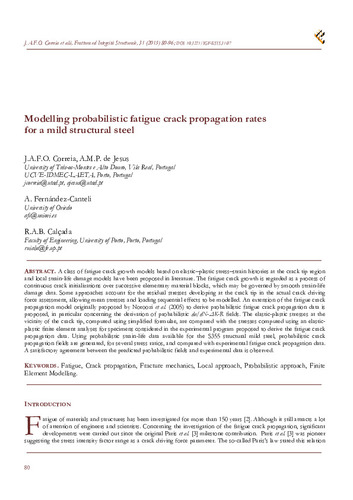Modelling probabilistic fatigue crack propagation rates for a mild structural steel
Subject:
Crack propagation
Publication date:
Editorial:
Gruppo Italiano Frattura
Publisher version:
Citación:
Descripción física:
Abstract:
A class of fatigue crack growth models based on elastic–plastic stress–strain histories at the crack tip region and local strain-life damage models have been proposed in literature. The fatigue crack growth is regarded as a process of continuous crack initializations over successive elementary material blocks, which may be governed by smooth strain-life damage data. Some approaches account for the residual stresses developing at the crack tip in the actual crack driving force assessment, allowing mean stresses and loading sequential effects to be modelled. An extension of the fatigue crack propagation model originally proposed by Noroozi et al. (2005) to derive probabilistic fatigue crack propagation data is proposed, in particular concerning the derivation of probabilistic da/dN-ΔK-R fields. The elastic-plastic stresses at the vicinity of the crack tip, computed using simplified formulae, are compared with the stresses computed using an elasticplastic finite element analyses for specimens considered in the experimental program proposed to derive the fatigue crack propagation data. Using probabilistic strain-life data available for the S355 structural mild steel, probabilistic crack propagation fields are generated, for several stress ratios, and compared with experimental fatigue crack propagation data. A satisfactory agreement between the predicted probabilistic fields and experimental data is observed
A class of fatigue crack growth models based on elastic–plastic stress–strain histories at the crack tip region and local strain-life damage models have been proposed in literature. The fatigue crack growth is regarded as a process of continuous crack initializations over successive elementary material blocks, which may be governed by smooth strain-life damage data. Some approaches account for the residual stresses developing at the crack tip in the actual crack driving force assessment, allowing mean stresses and loading sequential effects to be modelled. An extension of the fatigue crack propagation model originally proposed by Noroozi et al. (2005) to derive probabilistic fatigue crack propagation data is proposed, in particular concerning the derivation of probabilistic da/dN-ΔK-R fields. The elastic-plastic stresses at the vicinity of the crack tip, computed using simplified formulae, are compared with the stresses computed using an elasticplastic finite element analyses for specimens considered in the experimental program proposed to derive the fatigue crack propagation data. Using probabilistic strain-life data available for the S355 structural mild steel, probabilistic crack propagation fields are generated, for several stress ratios, and compared with experimental fatigue crack propagation data. A satisfactory agreement between the predicted probabilistic fields and experimental data is observed
ISSN:
Collections
- Artículos [36410]
- Construcción e Ingeniería de Fabricación [482]
Files in this item





